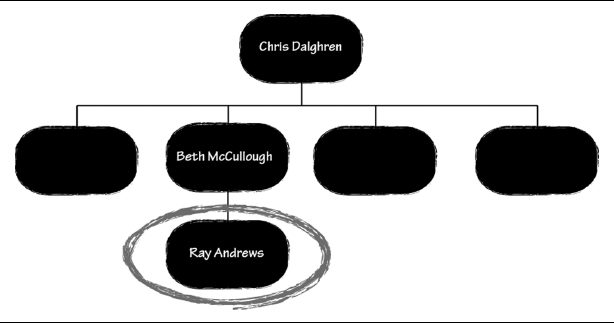The Power Base Principle
Let’s look at an organization that is about to make a major buying decision connected with an important project. Ray Andrews, an ambitious and young first-level manager, has been given responsibility to select a supplier. Although final approval rests with Ray’s boss, Beth McCullough, and the division’s Vice President, Chris Dalghren, the decision is primarily Ray’s. Figure 7.1 shows the organization chart. It’s not necessary to go into the details of this company or project; simply place your product and one of your customers into the picture as we go along.
Figure 7.1: Ray Andrews on His Department Organization Chart

Ray begins by identifying which features and benefits that he feels the product needs to have, and then he develops a list of suppliers who may offer those capabilities. He then issues a request for proposal (RFP), and you are one of the suppliers who respond to it. Fast-forward to the end of the sales cycle. After a successful sales campaign, you win the order.
Since Ray’s company is growing, Chris Dalghren is considering creating a new department. Whoever she names to run it will be on the same level as Beth McCullough. None of this is going to happen right away; it probably won’t take place until a year or so down the line. Now, suppose that Ray wants to be promoted to head the new department. Has he navigated the political waters within ...
Get The New Power Base Selling: Master The Politics, Create Unexpected Value and Higher Margins, and Outsmart the Competition now with the O’Reilly learning platform.
O’Reilly members experience books, live events, courses curated by job role, and more from O’Reilly and nearly 200 top publishers.

